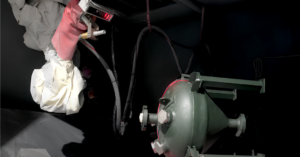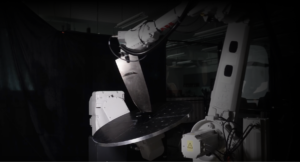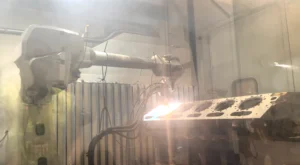table of contents
- Heading 1
- Heading 1
- Heading 1
share this
A study by Vanson Bourne showed that 23% of unplanned downtime in the manufacturing sector is a result of human error. Other industries on the other hand only have an average of 9%. The manufacturing industry suffers the most from human mistakes as any issue impacts the rest of the assembly line and results in a bottleneck. Reducing human error by reducing human interactions and interference is therefore the solution to further improve manufacturing processes and save on time and cost.
Industrial robots have been around since the 1960s. However, it was only until the 1990s that it became widely adopted by the manufacturing sector. Ever since, industrial robotics have scaled and evolved to become a billion dollar industry, having the ability to replace humans in a large spectrum of processes such as welding, polishing, sandblasting, etc. With the Covid-19 pandemic, many factories have taken steps to reduce human contact and increase automation, resulting in the robotics sector to further explode in popularity. In 2022, there are around 3.6 million robots deployed globally, of which 75% (2.7 million) of them are industrial robots in the manufacturing industry.
How are robotics used in the manufacturing process?
1. Welding
Welding is a meticulous and manual process. It is widely used in the manufacturing of automobile, aircrafts, architectural and structural metals. Often, there are variations in quality and defects. Welding today leverages heavily on robotics to improve productivity and produce consistent high-quality weld every time. This results in fewer do-overs, defects and better throughput.

Figure 1: Robotic Welding
2. Sanding
Sanding is used in the manufacturing of various veneers, structural parts, toys and handicrafts, decorations, furniture, floor and wall panels. The manual process of sanding is hazardous, leaving the safety of workers at risk as they are exposed to dust and debris which can cause significant health impacts. Sanding is also a labour-intensive and time-consuming process. Robots easily replace workers, improving productivity, safety and quality.

Figure 2: Robotic Sanding
3. Sandblasting & Shot Peening
Robot programming in industrial sandblasting applications requires massive amounts of code and CAD files to program robot waypoints and paths. This has resulted in the need for companies to hire trained robotic engineers who spend days programming a robotic paint path for a component. Robotic automations enable non-technical users, with little to no knowledge in robotics, to accurately plan robot paths and trajectories or select from pre-designed path templates to program industrial robots. Companies no longer need to hire specialised engineers as accessibility to robotics has increased over the years.
Save Cost with Robotic Automation
Industrial robotics offers many benefits including cost savings, consistency, accuracy, efficiency and safety. Since its inception, the manufacturing industry has been revolutionised. Augmentus aims to increase the accessibility to this revolutionary technology to more companies and impact more processes. This is done through offering a no-code and fully-integrated robotic programming software that enables anyone, even those with no robotic experience, to program dynamic industrial robots in minutes. Companies using Augmentus have experienced up to 70% cost reduction and 17 times faster deployments across a wide variety of applications, such as spraying, palletizing, welding, and inspections. Sign up for a demo with us today!
References:
- 35 + amazing robotics industry statistics to understand in 2022. STRATEGIC MARKET RESEARCH. (n.d.). Retrieved November 14, 2022, from https://www.strategicmarketresearch.com/blogs/robotics-industry-statistics
- Fortune Business Insights. (2022, August 24). Industrial Robots Market to hit USD 35.68 billion by 2029: At 11.4% CAGR. GlobeNewswire News Room. Retrieved November 14, 2022, from https://www.globenewswire.com/news-release/2022/08/24/2503600/0/en/Industrial-Robots-Market-to-Hit-USD-35-68-Billion-by-2029-At-11-4-CAGR.html
- Human error is more common cause of unplanned downtime in manufacturing than any other sector, according to New Research. Human Error is More Common Cause of Unplanned Downtime in Manufacturing Than Any Other Sector, According to New Research | Business Wire. (2017, November 7). Retrieved November 14, 2022, from https://www.businesswire.com/news/home/20171106006370/en/Human-Error-is-More-Common-Cause-of-Unplanned-Downtime-in-Manufacturing-Than-Any-Other-Sector-According-to-New-Research
- What is a sanding machine? carry out the sanding process. Market Prospects. (n.d.). Retrieved November 14, 2022, from https://www.market-prospects.com/articles/what-is-a-sanding-machine
- Kelsey, J. (2020, July 14). Choosing and using random-orbit Sanders. This Old House. Retrieved November 14, 2022, from https://www.thisoldhouse.com/woodworking/21018385/choosing-and-using-random-orbit-sanders
- Anglianblasting. (2019, May 10). What is sandblasting – how effective is it at removing paint? Anglian Blasting Ltd – Blog. Retrieved November 14, 2022, from https://anglianblasting.com/blog/what-is-sandblasting-for-removing-paint/



